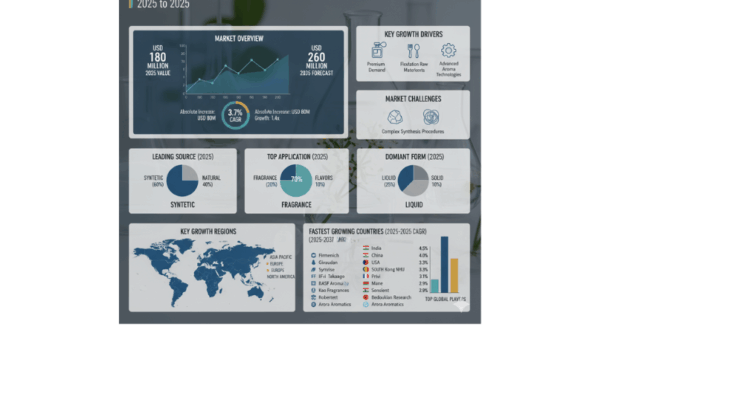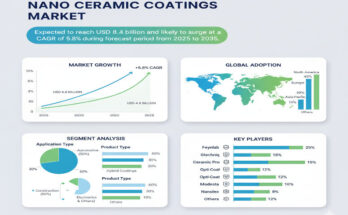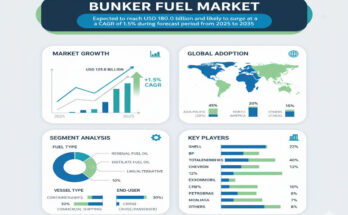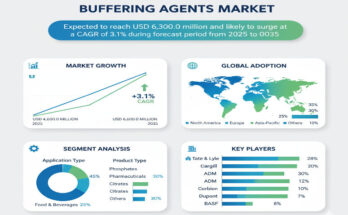The global Beta-Damascenone market is on a steady trajectory toward USD 260 million by 2035, reflecting an absolute growth of USD 80 million from its 2025 valuation of USD 180 million, according to the latest industry forecast. With a projected compound annual growth rate (CAGR) of 3.7%, Beta-Damascenone continues to solidify its position as a key aroma compound underpinning the world’s luxury perfumery, flavor enhancement, and specialty fragrance industries.
Market Momentum: From Niche Molecule to Industry Essential
Beta-Damascenone—a vital aroma ingredient known for its rich, fruity-floral notes reminiscent of roses, apples, and honey—is experiencing an unprecedented rise in adoption across the fragrance and flavor value chain.
Between 2025 and 2030, the market will expand from USD 180 million to USD 215.7 million, contributing 44.6% of total forecast growth. During the subsequent 2030–2035 period, the market is expected to accelerate further to USD 260 million, adding USD 44.3 million in value—representing 55.4% of decade-long expansion.
This trajectory underscores the compound’s critical role in premiumization trends across global fragrance portfolios. Manufacturers and fragrance houses are increasingly leveraging synthetic and natural Beta-Damascenone to achieve consistent olfactory performance, regulatory compliance, and cost-effective formulation scalability.
Regional Growth Hotspots: Asia Pacific Leads the Scent Revolution
Among all regions, Asia Pacific is poised to lead global growth, with India emerging as the fastest-growing market at a CAGR of 4.5%, followed by China (4.0%), reflecting rapid fragrance infrastructure development and government-backed aroma innovation programs.
- India’s Leadership: Anchored by expanding perfumery hubs in Mumbai, Delhi, Bangalore, and Chennai, the country’s fragrance modernization initiatives and “Make in India” manufacturing policies are fueling robust adoption of Beta-Damascenone in both luxury perfumery and mass-market applications.
- China’s Modernization Drive: With a 4.0% CAGR, China’s adoption of integrated aroma solutions aligns with national goals for fragrance innovation and domestic value creation under the Belt and Road Initiative.
- North America and Europe: The United States maintains strong demand (CAGR 3.3%) driven by modernization across perfumery centers like New York and Los Angeles, while Germany, Japan, and France continue to emphasize regulatory excellence and luxury fragrance standards.
Market Segmentation: Synthetic Dominates, Fragrance Applications Lead
By Source:
The synthetic Beta-Damascenone segment will account for approximately 60% of the market in 2025, driven by advancements in chemical synthesis technologies, multi-application compatibility, and cost optimization. Synthetic variants offer manufacturers superior quality consistency, regulatory predictability, and production scalability, making them the preferred choice for industrial fragrance applications.
Meanwhile, the natural Beta-Damascenone segment (40%) continues to hold strategic importance for ultra-premium and artisanal perfumery, where authenticity and botanical sourcing remain key differentiators.
By Application:
Fragrance applications represent 70% of global demand, underscoring the compound’s pivotal role in luxury perfumes, fine fragrances, and cosmetic aroma systems. Flavor applications account for 20%, benefiting from heightened consumer demand for natural and premium-tasting beverages and foods. The remaining 10% is attributed to niche uses in personal care, cosmetics, and industrial scenting systems.
By Form:
The liquid form commands a dominant 85% share, reflecting widespread adoption in liquid formulations, fragrance blending systems, and scalable aroma delivery platforms. Solid forms, capturing 15%, cater to stability-focused and powdered formulations, particularly in controlled-release or encapsulated applications.
Key Growth Drivers: Innovation, Premiumization, and Regulation
The Beta-Damascenone market’s momentum is sustained by three principal forces:
- Luxury and Premium Fragrance Expansion: Global perfumery and personal care industries are experiencing an 8–12% annual rise in high-end fragrance launches, intensifying the need for stable and high-intensity aroma compounds.
- Government and Industry Support: National programs promoting fragrance modernization and quality compliance—particularly in Asia and the EU—are driving large-scale adoption of certified aroma compounds such as Beta-Damascenone.
- Technological Advancements: Innovations in chemical synthesis pathways, process optimization, and multi-application formulation systems are reducing production complexity and enhancing fragrance intensity by up to 95% compared to natural extracts.
However, volatile raw material costs and stringent regulatory frameworks continue to challenge smaller producers, emphasizing the importance of collaborative R&D ecosystems and public-private partnerships for long-term growth.
Competitive Landscape: Innovation Defines Leadership
The Beta-Damascenone industry is moderately consolidated, with 15–20 key players controlling a significant share of global supply. Market leaders such as Firmenich, Givaudan, and Symrise collectively account for 30–40% of total market value, leveraging extensive R&D resources, deep technical expertise, and established relationships with major fragrance houses.
- Firmenich commands ~15% market share, supported by advanced aroma molecule innovation and comprehensive technical service frameworks.
- Givaudan and Symrise are expanding portfolios in synthetic aroma compounds and bio-based damascenone alternatives, focusing on sustainable chemistry.
- Emerging players such as Privi, Zhejiang NHU, and Arora Aromatics are gaining ground in Asia-Pacific markets through competitive pricing, local manufacturing, and regulatory agility.
Future Outlook: Collaboration and Technology Integration to Define the Next Decade
The decade ahead will be defined by cross-industry collaboration between fragrance manufacturers, chemical producers, and research institutions. The integration of intelligent aroma platforms, real-time fragrance monitoring, and AI-assisted formulation systems is expected to enhance precision, reduce formulation time, and optimize performance.
Governments are encouraged to support the sector through:
- Fragrance development incentives and innovation funding for local aroma facilities.
- Tax and R&D support programs for companies investing in sustainable synthesis technologies.
- Standardized regulatory frameworks that harmonize testing and safety compliance globally.
Industry associations can further accelerate adoption by developing certification programs for product safety and performance, while manufacturers are urged to expand their service and support networks to assist perfumery operations across emerging markets.
About the Beta-Damascenone Market Study
This comprehensive analysis covers global market projections, segmental breakdowns by source, application, and region, and detailed profiles of leading companies shaping the fragrance industry’s future. With its CAGR of 3.7%, the Beta-Damascenone market stands as a cornerstone of global aroma innovation—where science, creativity, and sustainability converge.
For manufacturers, technology partners, and investors, the next decade offers a transformational opportunity to redefine fragrance chemistry, elevate sensory experiences, and capture the expanding demand for premium, high-performance aroma compounds worldwide.
Beta-Damascenone Market https://www.factmr.com/report/beta-damascenone-market



